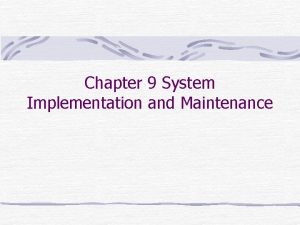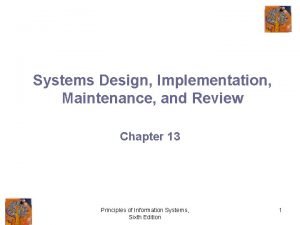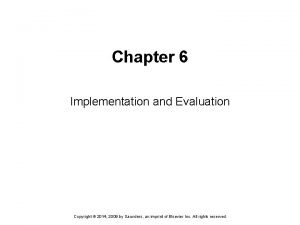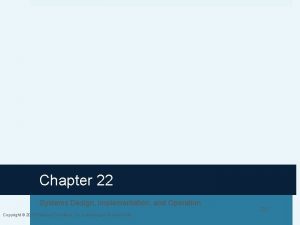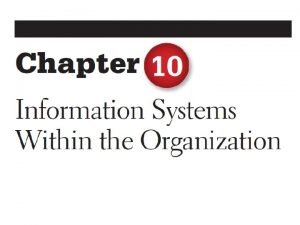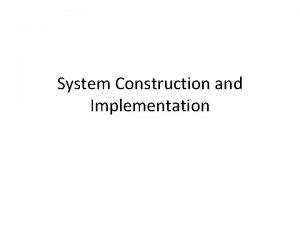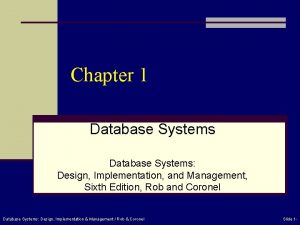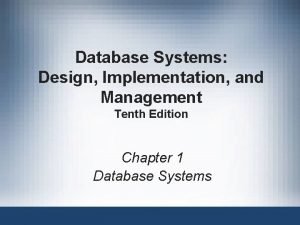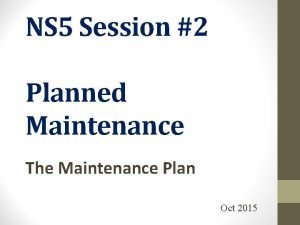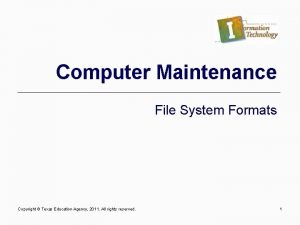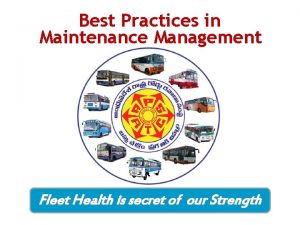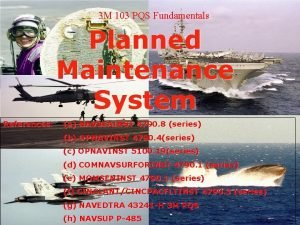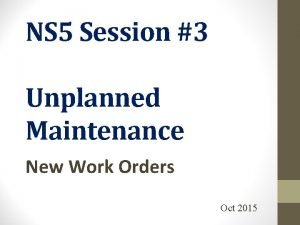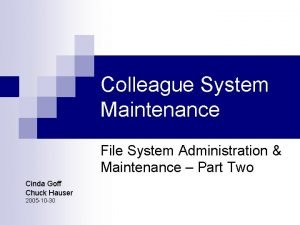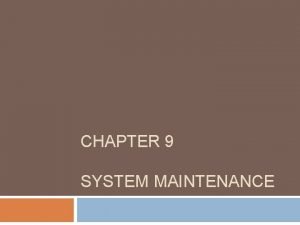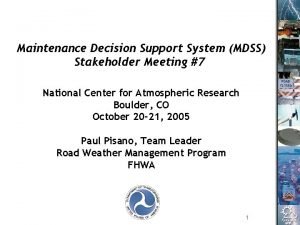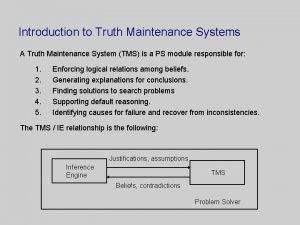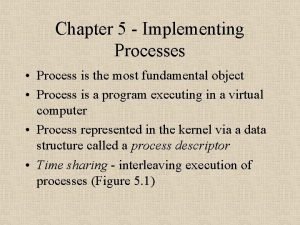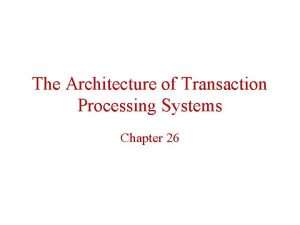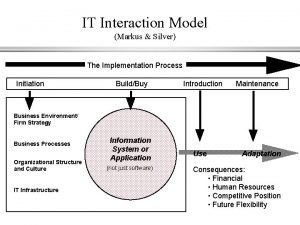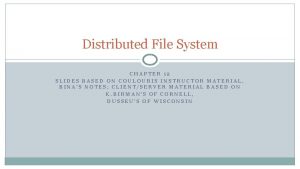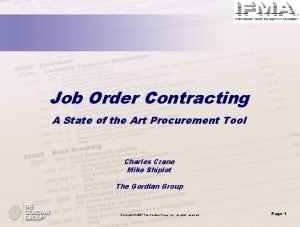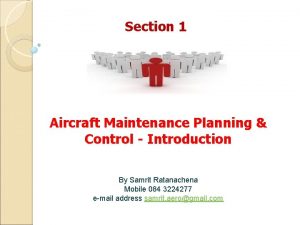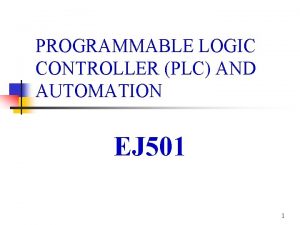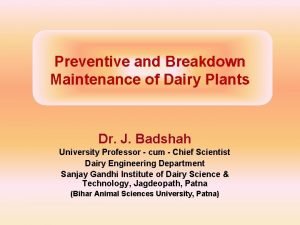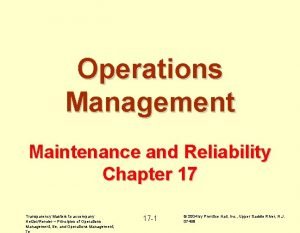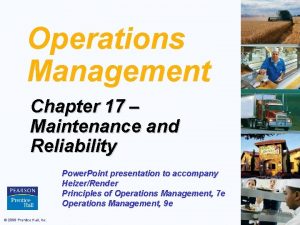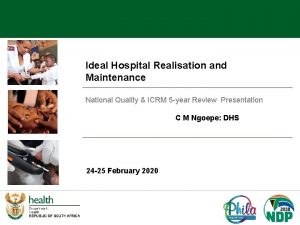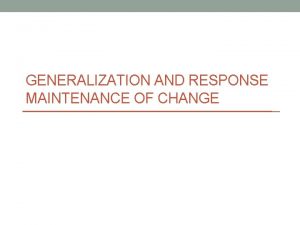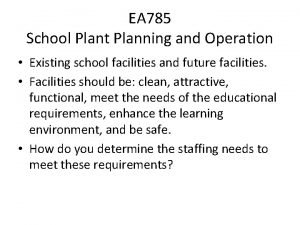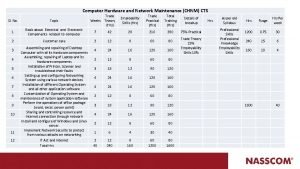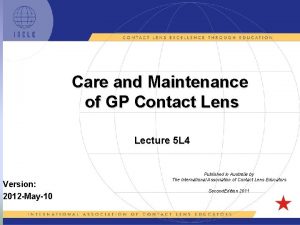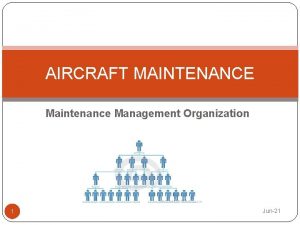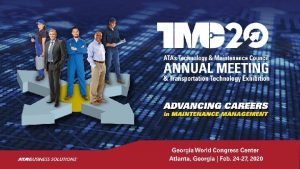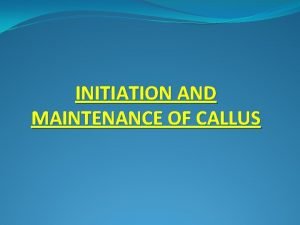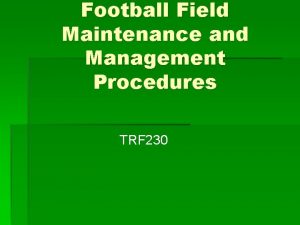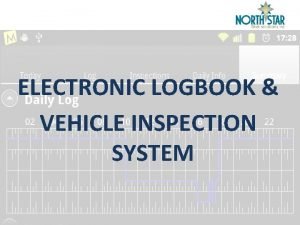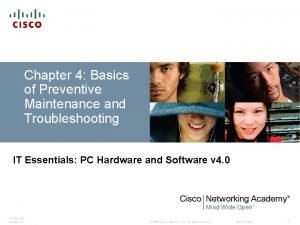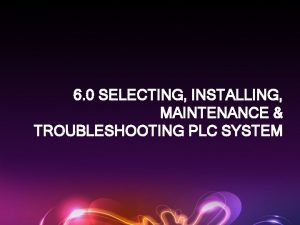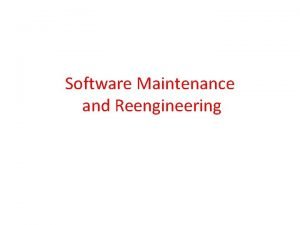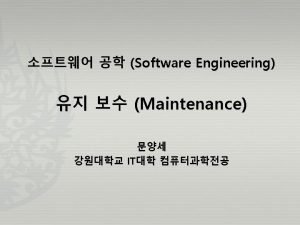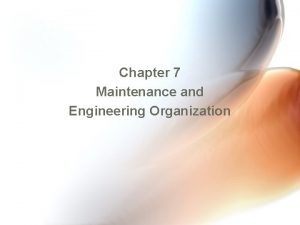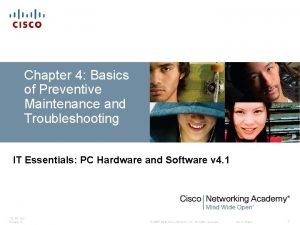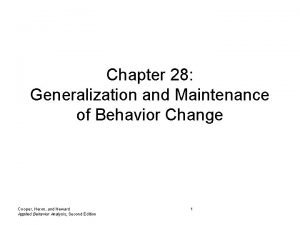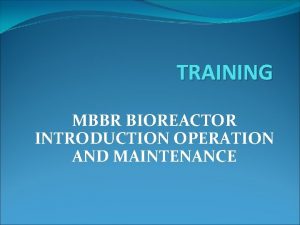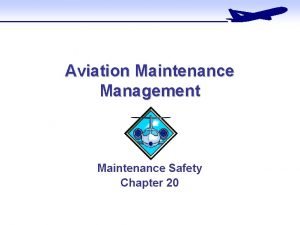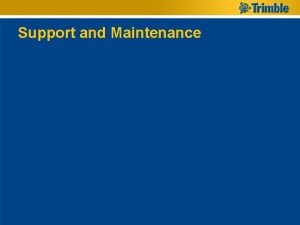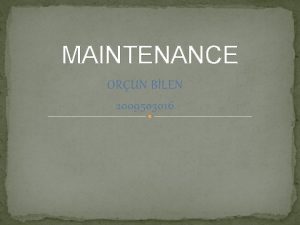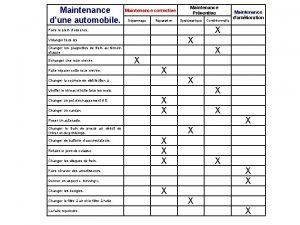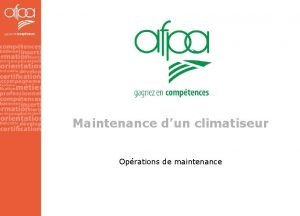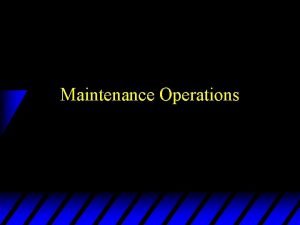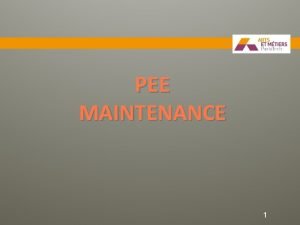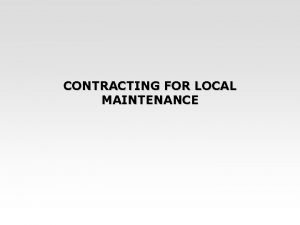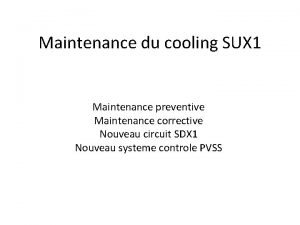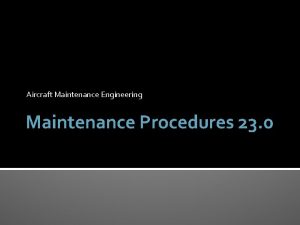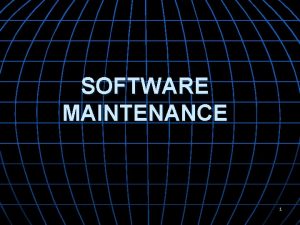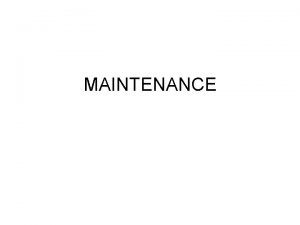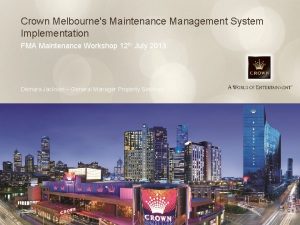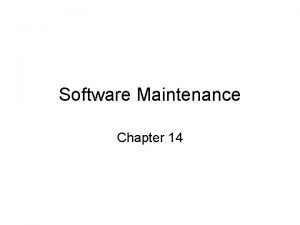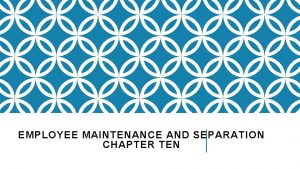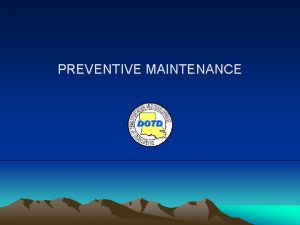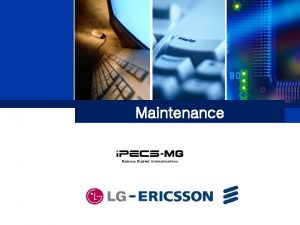Chapter 9 System Implementation and Maintenance System Implementation





























































- Slides: 61

Chapter 9 System Implementation and Maintenance

System Implementation and Maintenance Seven major activities Coding Testing Installation Documentation Training Support Maintenance Purpose To convert final physical system specifications into working and reliable software To document work that has been done To provide help for current and future users

The Process of Coding, Testing and Installation Coding Physical design specifications are turned into working computer code Testing Tests are performed using various strategies Testing can be performed in parallel with coding Installation Process during which the current system is replaced by the new system

The Process of Coding, Testing and Installation

The Process of Documenting the System, Training Users and Supporting Users Two audiences for documentation The information systems personnel who will maintain the system throughout its productive life The people who will use the system as part of their daily lives Deliverables Documentation System documentation User training plan Classes Tutorials User training modules Training materials Computer-based training aids User support plan Help desk On-line help Bulletin boards and other support mechanisms

The Process of Maintaining Information Systems Process of returning to the beginning of the SDLC and repeating development steps focusing on system change until the change is implemented Four major activities 1. Obtaining maintenance requests 2. Transforming requests into changes 3. Designing changes 4. Implementing changes

The Process of Maintaining Information Systems Deliverables and Outcomes Development of a new version of the software and new versions of all design documents created or modified during the maintenance effort

Software Application Testing A test plan is developed during the analysis phase During the design phase, a unit test plan and a system test plan are developed The actual testing is done during implementation Test plans provide improved communication among all parties involved in testing Serve as checklists

Software Application Testing Test Plan 1. Introduction a. Description of system to be tested b. Objectives of the test plan c. Method of testing d. Supporting documents 2. Overall Plan a. Milestones, schedule, and location b. Test materials 1. Test plans 2. Test Cases 3. Test Scenarios 4. Test Log c. Criteria for passing tests

Software Application Testing 3. Testing Requirements a. Hardware b. Software c. Personnel 4. Procedure Control a. Test Initiation b. Test Execution c. Test Failure d. Access/Change Control e. Document control

Software Application Testing 5. Test Specific or Component Specific Test Plans a. Objectives b. Software description c. Method d. Milestones, schedule, progression, and location e. Requirements f. Criteria for passing tests g. Resulting test materials h. Execution control i. Attachment

Software Application Testing Types of Testing Inspection A testing technique in which participants examine program code for predictable language-specific errors Walkthrough A peer group review of any product created during the systems development process; also called a structured walkthrough Desk Checking A testing technique in which the program code is sequentially executed manually by the reviewer

Software Application Testing Types of Testing Unit Testing Each module is tested alone in an attempt to discover any errors in its code, also called module testing Integration Testing The process of bringing together all of the modules that a program comprises for testing purposes. Modules are typically integrated in a top-down, incremental fashion

Software Application Testing Types of Testing System Testing The bringing together of all the programs that a system comprises for testing purposes. Programs are typically integrated in a top-down, incremental fashion Stub Testing A technique used in testing, especially where modules are written and tested in a top-down fashion, where a few lines of code are used to substitute for subordinate modules

Comparing Stub and Integration Testing

Software Application Testing The Testing Process 1. The purpose of the testing is confirming that the system satisfies requirements 2. Testing must be planned Test Case A specific scenario of transactions, queries or navigation paths that represent a typical, critical or abnormal use of the system Test cases and results should be thoroughly documented so they can be repeated for each revision of an application

Software Application Testing Acceptance Testing by Users The process whereby actual users test a completed information system, the end result of which is the users’ acceptance of it

Software Application Testing Acceptance Testing by Users Alpha Testing - User testing of a completed information system using simulated data Recovery testing Forces the software (or environment) to fail in order to verify that recovery is properly performed Security testing Verifies that protection mechanisms built into the system will protect it from improper penetration Stress testing Tries to break the system Performance testing Determines how the system performs on the range of possible environments in which it may be used

Software Application Testing Acceptance Testing by Users Beta Testing User testing of a completed information system using real data in the real user environment

Software Quality • How many problems have been found with a product • Whether the product is ready for release to the next development stage or to the customer? • How the current version of a product compares in quality with previous or competing versions? • How effective are the prevention, detection, and removal processes?

Software Quality The terminology is not uniform!! Measure - If an organization measures its software quality in terms of faults per thousand lines of code.

Software Quality - Terminology Fault Failure Human Error IEEE standard 729 A fault occurs when a human error results in a mistake in some software product. (incorrect code as well as incorrect instructions in the user manual) A failure is the departure of a system from its required behavior.

Software Quality - Terminology Errors - often means faults Anomalies - A class of faults that are unlikely to cause failures in themselves but may nevertheless eventually cause failures indirectly. Ex. Non-meaningful variable name Defects - normally refer collectively to faults and failures Bugs - faults occurring in the code Crashes - a special type of failure, where the system ceases to failure.

Software Quality - Terminology The reliability of a software system is defined in terms of failures observed during operation , rather than in terms of faults.

Software Quality Key elements for the problem is observed • Location - where did the problem occur • Timing - when did it occur • Symptom - what was observed • End Result - which consequences resulted • Mechanism - how did it occur • Cause - why did it occur • Severity - how much was the user affected • Cost - how much did it cost

Failure Report Location – installation where failure was observed Timing – CPU time, clock time or some temporal measure Symptom – Type of error message or indication of failure End Result – Description of failure, such as “operation system crash, ” “services degraded, ” “loss of data, ” “wrong output, ” “no output” Mechanism – Cain of events, including keyboard commands and state data, leading to failure. What function the system was performed or how heavy the workload was when the failure occurred

Failure Report Cause – Reference the possible fault(s) leading to failure trigger: physical hardware failure operating conditions malicious action user erroneous report source: unintentional design fault usability problem Severity – “Critical, ” “Major, ” “Minor” Cost – Cost to fix plus lost of potential business

Fault Report Location – within-system identifier (and version), such as module or document name Timing – Phases of development during which fault was created, detected, and corrected Symptom – Type of error message reported (IEEE standard on software anomalies, 1992) End Result – Failure caused by the fault Mechanism – How source was created (specification, coding, design, maintenance), detected(inspection, unit testing, system testing, integration testing), corrected(step to correct it)

Fault Report Cause – Type of human error that led to fault: communication: imperfect transfer of information conceptual: misunderstanding clerical: typographical or editing errors Severity – Refer to severity of resulting or potential failure Cost – Time or effort to locate and correct

Change Report Location – identifier of document or module changed Timing – When change was made Symptom – Type of change End Result – Success of change Mechanism – How and by whom change was performed Cause – Corrective, adaptive, preventive, or perfective Severity – Impact on rest of system Cost – Time and effort for change implementation and test

Refined Failure Data for Software Reliability Time Domain Data – recording the individual times at which the failure occurred (provide better accuracy in the parameter estimates) Interval Domain Data – counting the number of failures occurring over a fixed period

Time domain approach Failure records Actual Failure Time Between Failure 1 2 3 4 5 25 55 70 95 112 25 30 15 15 17

Interval domain approach Time Observed Number of Failures 0 1 2 3 4 0 2 4 1 1

Software Fault Type Thayer et al. (1978) Computational errors Logical errors Input/output errors Data handling errors Operating system/system support error Configuration errors User interface errors Data base interface errors Present data base errors Global variable definition errors Operator errors Unidentified errors

Fault Introduced in the Software Life Cycle Requirement and Specification Design - Function Design Logical Design Coding Testing Maintenance

Error Removed in the Software Life Cycle Validation Unit Testing Integration Testing Acceptance Testing Operation and Demonstration

Installation The organizational process of changing over from the current information system to a new one Four approaches Direct Installation Changing over from the old information system to a new one by turning off the old system when the new one is turned on Parallel Installation Running the old information system and the new one at the same time until management decides the old system can be turned off

Installation Single location installation Trying out an information system at one site and using the experience to decide if and how the new system should be deployed throughout the organization Phased Installation Changing from the old information system to the new one incrementally, starting with one or a few functional components and then gradually extending the installation to cover the whole new system

Installation Direct Installation Parallel Installation

Installation Single Location Installation

Installation Phased Installation

Planning Installation Considerations Data conversion Error correction Loading from current system Planned system shutdown Business cycle of organization Installation 的時機

Documenting The System documentation Detailed information about a system’s design specifications, its internal workings and its functionality Internal documentation System documentation that is part of the program source code or is generated at compile time External documentation System documentation that includes the outcome of structured diagramming techniques such as data flow and entity relationship diagrams

Documenting The System User Documentation Written or other visual information about an application system, how it works, and how to use it Preparing user documentation Traditional source has been information systems department Application-oriented documentation is now often supplied by vendors and users themselves

Documenting The System Traditional Information System Environment and its Focus on System Documentation

Documenting The System End User Information System Environment and its Focus on User Documentation

Training Information System Users Potential training topics Use of the system General computer concepts (copy file) Information system concepts (batch processing) Organizational concepts (FIFO inventory accounting) System management (request changes) System installation

Training Information System Users Training methods Resident expert Computer-aided instruction Formal courses Software help components Tutorials Interactive training manuals External sources, such as vendors Electronic performance support system (EPSS) Component of a software package or application in which training and educational information is embedded

Supporting Information System Users Support is extremely important to users J. D. Power and Associates survey found user support to be number one criterion contributing to user satisfaction with personal computing Most organizations provide support by two means Information center Help desk

Supporting Information System Users Information Center An organizational unit whose mission is to support users in exploiting information technology Staff might perform the following tasks Install new hardware or software and set up user accounts Consult with users writing programs in fourth-generation languages Extract data from organizational databases onto personal computers Answer basic on-demand questions Provide a demonstration site for viewing hardware and software Work with users to submit system change requests

Supporting Information System Users Help Desk A single point of contact for all user inquiries and problems about a particular information system or for all users in a particular department

Why Implementation Sometimes Fails Two conditions necessary for a successful implementation Management support of the system under development Involvement of users in the development process system complex -> ok financial and time constraints -> not really

Why Implementation Sometimes Fails Insights about implementation process Risk (user involvement) Commitment to the project (actual solve the problem) Commitment to change (User and manager willing to change) Extent of project definition and planning (how well planned the project is) Realistic user expectations Implementation success factors Extent to which system is used User’s satisfaction with system

Why Implementation Sometimes Fails Implementation success factors 1. User’s personal stake - How relevant the system is to the work the user performs 2. System Characteristics - System ease of use and reliability 3. User Demographics - Such as age and degree of computer experience 4. Organization Support 5. Performance 6. satisfaction

Conducting System Maintenance Corrective maintenance Changes made to a system to repair flaws in its design, coding, or implementation Adaptive maintenance Changes made to a system to evolve its functionality to changing business needs or technologies Perfective maintenance Changes made to a system to add new features or to improve performance Preventive maintenance Changes made to a system to avoid possible future problems

Conducting System Maintenance The Cost of Maintenance Many organizations allocate eighty percent of information systems budget to maintenance Factors that influence system maintainability Latent defects Number of customers for a given system Quality of system documentation Maintenance personnel Tools Well-structured programs

Conducting System Maintenance Measures of Effectiveness Number of failures Time between each failure Type of failure Mean time between failures (MTBF) A measurement of error occurrences that can be tracked over time to indicate the quality of a system

Controlling Maintenance Requests Determine type of request Error Adaptation Enhancement

Controlling Maintenance Requests Flow Chart of How to Control Maintenance Requests

Controlling Maintenance Requests

Configuration Management The process of assuring that only authorized changes are made to the system Baseline modules Software modules that have been tested, documented, and approved to be included in the most recently created version of a system System librarian A person responsible for controlling the checking out and checking in of baseline modules when a system is being developed or maintained Build routines Guidelines that list the instructions to construct an executable system from the baseline source code
 System implementation and maintenance
System implementation and maintenance Chapter 9 vehicle maintenance
Chapter 9 vehicle maintenance System maintenance and review
System maintenance and review Chapter 6 implementation and evaluation
Chapter 6 implementation and evaluation System implementation and operation
System implementation and operation Objectives of transaction processing system
Objectives of transaction processing system System construction and implementation
System construction and implementation Database system design implementation and management
Database system design implementation and management Database systems 10th edition
Database systems 10th edition Importance of records and reports
Importance of records and reports Vessel planned maintenance system excel
Vessel planned maintenance system excel File system maintenance
File system maintenance Fleet maintenance management system best practices
Fleet maintenance management system best practices Mip pqs
Mip pqs Ns5 maintenance system
Ns5 maintenance system Smoke control system maintenance
Smoke control system maintenance File system maintenance
File system maintenance Explain system maintenance
Explain system maintenance Maintenance decision support system
Maintenance decision support system Truth maintenance system
Truth maintenance system Implementation of process in operating system
Implementation of process in operating system Transaction processing system architecture
Transaction processing system architecture Phase of system development life cycle
Phase of system development life cycle Cse 132
Cse 132 Rpc implementation in distributed system
Rpc implementation in distributed system It interaction model in mis
It interaction model in mis Distributed file system notes
Distributed file system notes A model that is the demo implementation of the system.
A model that is the demo implementation of the system. State of the art contracting
State of the art contracting Preventive and predictive maintenance of hydro power plant
Preventive and predictive maintenance of hydro power plant Aircraft maintenance planning
Aircraft maintenance planning Plc installation troubleshooting and maintenance
Plc installation troubleshooting and maintenance Operation and maintenance dairy plant
Operation and maintenance dairy plant Maintenance and reliability in operations management
Maintenance and reliability in operations management Maintenance and reliability in operations management
Maintenance and reliability in operations management Mao consolidation and maintenance of power
Mao consolidation and maintenance of power Da form 5988e
Da form 5988e Premier asset management llc
Premier asset management llc An ideal hospital
An ideal hospital Use indiscriminable contingencies
Use indiscriminable contingencies Maintenance and selection of site for school plant
Maintenance and selection of site for school plant Chnm
Chnm Health promotion world health organization
Health promotion world health organization Sereine extra strength daily cleaner
Sereine extra strength daily cleaner Mro organization chart
Mro organization chart Technology and maintenance council
Technology and maintenance council Initiation and maintenance of callus culture
Initiation and maintenance of callus culture Football field maintenance cost
Football field maintenance cost Digital logbook maintenance and inspection
Digital logbook maintenance and inspection Preventive maintenance and troubleshooting
Preventive maintenance and troubleshooting Preventive maintenance and troubleshooting
Preventive maintenance and troubleshooting Maintenance goals and objectives
Maintenance goals and objectives Auto upkeep answer key
Auto upkeep answer key Plc installation troubleshooting and maintenance
Plc installation troubleshooting and maintenance Maintenance and reengineering
Maintenance and reengineering Adaptive and corrective maintenance
Adaptive and corrective maintenance Maintenance and engineering organization
Maintenance and engineering organization Preventive maintenance and troubleshooting
Preventive maintenance and troubleshooting Program common stimuli aba
Program common stimuli aba Boiler operation and maintenance training ppt
Boiler operation and maintenance training ppt Maintenance rules and regulations
Maintenance rules and regulations Mbbr operation and maintenance manual
Mbbr operation and maintenance manual
